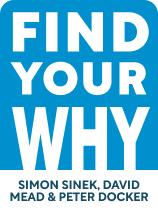

This article is an excerpt from the Shortform book guide to "Find Your Why" by Simon Sinek, David Mead, Peter Docker. Shortform has the world's best summaries and analyses of books you should be reading.
Like this article? Sign up for a free trial here .
What are the best examples from Find Your Why? How does Simon Sinek explain discovering your purpose?
In this article, we’ll break down Sinek’s book Find Your Why by taking a closer look at the book’s best examples for understanding and living your purpose. These Find Your Why examples explain the practical process Sinek advocates for finding your purpose.
Read on for an overview of the best Find Your Why examples Simon Sinek gives for discovering and living your purpose.
Your Purpose Is at the Core of Everything You Do
We’ve discussed the importance of finding your purpose and its benefits. Next, we’ll explore how to use your purpose to guide your life and work. We’ll start with a three-part model Sinek first introduced in Start With Why, which illustrates how having a central purpose affects your actions (your “How” or methods) and your results (“What” you accomplish).
Sinek’s “Golden Circle” Example
Sinek created the “Golden Circle” example in Find Your Why to help you find fulfillment by placing your day-to-day actions and your strengths in the context of your purpose, or Why. In other words, his model helps you see whether the action you’re taking aligns with your purpose and thus whether it will bring you fulfillment or distract you from your Why.
(Shortform note: In Designing Your Life, Bill Burnett and Dave Evans provide a similar tool: a Life Compass. It places your life and work philosophies side by side so you can identify where they overlap and determine whether your actions are in accord with your philosophies, or beliefs about what you do and why.)
Sinek’s model consists of three concentric circles. Each circle represents one of the core concepts in his theory.
1. The innermost circle is the Why: the purpose that orients everything you do. It’s the core belief that motivates you to get out of bed in the morning. In terms of an organization, it’s the mission you stand for and the reason you’re in business. An organization’s Why might be to provide accessible health care to its community. An individual’s Why might be to create spaces for learning.
2. The middle circle is the How: your typical methods and practices that characterize you, and which other people consider your strengths. Your How brings your Why to life. An organization’s How or method might be to always pursue the most sustainable alternatives. An individual’s How might be to forge meaningful connections.
3. The outermost circle is the What: the outputs or results you generate. It’s the tangible part of your organization or life and the easiest to identify. An organization’s What includes its products, services, policies, and strategies. An individual’s What might be their family, job, and projects.
(Shortform note: While fans praise Sinek for clearly and succinctly bringing together three important elements of an organization’s or individual’s work, critics point out that his model is missing one core question: Who? They argue that organizations that use Sinek’s model and begin from Why, as he instructs, overlook the most important element in a business: the customers. An organization might have a compelling Why, but if they can’t find a customer who’s interested in it, they won’t be successful. Thus, you might want to complement Sinek’s model by asking yourself who you’re serving and what they need before you ask yourself why you’re in the business of serving them.)
Find Your Why Example From SpaceX
Elon Musk’s space flight company, SpaceX, leads with Why.
The company boasts outcomes including spacecraft, satellites, and human spaceflight projects. However, listing these outcomes doesn’t fully explain what makes SpaceX inspiring when compared to other space flight companies creating similar products.
One of the methods SpaceX takes to reach these outcomes is pursuing sustainability and commercial viability simultaneously. This led them to create reusable spacecraft, a rideshare service for satellites and commercial space flights. But, again, companies like Blue Origin and Virgin Galactic have similar methods. So why does SpaceX stand out?
It comes down to SpaceX’s purpose: Its mission—or Why—is to make humanity multiplanetary. According to Musk himself, that purpose is what separates his organization from its competitors. It does so because it triggers our fears and hopes by appealing to a deep human desire to: a) survive the existential challenges on earth, and b) discover what lies beyond what we already know.
Example of Determining Your How
The process of identifying your How, or methods, is the same for individuals and teams:
First, group similar themes until you have no more than five. (Remember not to use the themes you already wrote into your purpose declaration) These themes are your How, or methods. Sinek recommends stating your How in actionable language that will be easy to understand. Make the statements active, declarative, and inspiring. For example, “make room for people’s feelings” instead of “be empathetic.”
Then, elaborate on each How to make it more concrete. For instance, if a How states “we build safe communities,” you could add the following clarifying statements:
- “We look out for our community members.”
- “We create safe spaces where everyone belongs.”
- “We seek opportunities for connection.”
| Distinguish Your True Strengths From Personality Myths Besides helping you understand which situations bring out the best in you, writing down your How, or methods, is an opportunity to identify myths you might be holding about yourself. Among the themes you identified, you might have included myths about your personality—traits you believe you have and that even shape the way you tell stories about yourself, but that are inaccurate. For example, if you consider yourself organized, you might tell stories in a way that highlights that trait without considering how factually based it is. Thinking through your identified strengths and elaborating on them to make them more specific (for example, asking yourself, “How exactly am I organized?”) is an opportunity to shine a light on these myths and root them out. |
Find Your Why: Examples of Living Your Purpose
Sinek argues that identifying your Why (purpose) and How (methods) helps you find fulfillment in several ways:
Looking back, you can notice patterns in the types of outcomes (What) that gave you the most satisfaction—they were the ones that aligned with your Why and allowed you to apply your How.
Looking at the present, you can decide whether your current situation is the right fit for you. In some cases, having your purpose and methods put into words will reveal that the work you’re doing doesn’t align with your purpose or strengths. If you can’t amend this by finding another job, Sinek advises that you live your purpose where you are today, even if the context you’re in isn’t ideal.
For example, let’s say Jane is working at her current job only because she needs the money. Her purpose is “to build vibrant online communities around leaders and tastemakers so that people can find their tribes and thrive together.” Ideally, she’d be a community manager for a lifestyle brand or an influencer, but right now, she’s working as an assistant to a small business owner. Despite this limitation, she can still decide how to show up every day and affect the people she works with, and live true to her purpose. For instance, she might start an online group with coworkers around a common interest or pitch ideas to her boss on how to energize their online following.
Looking forward, you can intentionally seek out and nurture the work that’s most fulfilling for you, using your Why and How as filters to help you capture the right opportunities.
(Shortform note: Your work might not be the area of your life in which you personally need to find fulfillment. According to research, people see their work either as a job (something they do for money and aren’t attached to), a career (something they do to get ahead in life), or a calling (something that’s inherently fulfilling). If work for you is a job or a career, not a part of life where you seek fulfillment, consider whether you can apply your Why to other spheres of your life, like passion projects or your family.)

———End of Preview———
Like what you just read? Read the rest of the world's best book summary and analysis of Simon Sinek, David Mead, Peter Docker's "Find Your Why" at Shortform .
Here's what you'll find in our full Find Your Why summary :
- Simon Sinek’s steps to understanding and living your purpose and your organization’s
- How to create and write your purpose statement
- What to do after you find your Why: Determine your How






